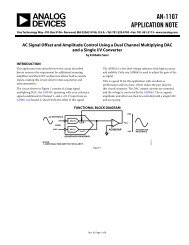Brett Fox - EEWeb
Brett Fox - EEWeb
Brett Fox - EEWeb
You also want an ePaper? Increase the reach of your titles
YUMPU automatically turns print PDFs into web optimized ePapers that Google loves.
TECHNICAL ARTICLE<br />
Some loads may require different controlled parameters<br />
at different times. Such an example is a battery charger<br />
which might require constant current for battery charge<br />
mode and constant voltage for battery maintenance<br />
mode.<br />
Loads will require the controlled parameter to be within a<br />
certain tolerance band for proper operation. The power<br />
supply must maintain the controlled parameter within<br />
the tolerance band.<br />
These parameters may be expressed in terms of average,<br />
RMS, or a peak value with a duration qualifier.<br />
Dynamic Requirements<br />
Loads also exhibit dynamic characteristics which change<br />
over time.<br />
Time Transients<br />
Many types of loads frequently change their effective<br />
impedance. Such an example might be a computer<br />
printer which exhibits rapid step changes in effective<br />
impedance. For such a device to function properly, the<br />
power supply must be able to rapidly source spurts<br />
of output current while maintaining the output voltage<br />
within a specified band. This means that the power<br />
supply must have enough output capacitance and high<br />
enough control loop bandwidth to maintain the output<br />
Vsource<br />
Power Supply<br />
Zout<br />
Feedback<br />
and<br />
Control<br />
Figure 1: Simplified representation of power supply and load.<br />
voltage within the prescribed limits. Loads which have<br />
this type of behavior must have power supplies specified<br />
to limit the droop on the leading edge of the pulse, and<br />
recover to within a certain band of the steady state output<br />
in a prescribed time interval.<br />
Voltage Dependence<br />
Non-linear loads change impedance as voltage is<br />
increased. One example is a typical solid-state circuit<br />
which might draw very little current at low voltages,<br />
and then begin to draw current with a very rapid and<br />
nonlinear increase as voltage is increased.<br />
A more problematic configuration is cascading a power<br />
supply with a second power supply of a switching<br />
converter design. A switching converter has a nonlinear<br />
negative resistance characteristic. At very low input<br />
voltages, below the turn-on threshold, the current may<br />
be miniscule. When the input voltage is increased to<br />
the turn-on threshold, the input current suddenly draws<br />
very high current. As the input voltage is increased, the<br />
input current decreases, following a constant power<br />
characteristic. If care is not taken in the first power<br />
supply design and cable length, the load (the switching<br />
converter) will cycle on and off because of the voltage<br />
drop in the cable length and/or the output impedance of<br />
the power supply.<br />
<strong>EEWeb</strong> | Electrical Engineering Community Visit www.eeweb.com 14<br />
Iload<br />
Zload<br />
+<br />
Vload<br />
_<br />
TECHNICAL ARTICLE















